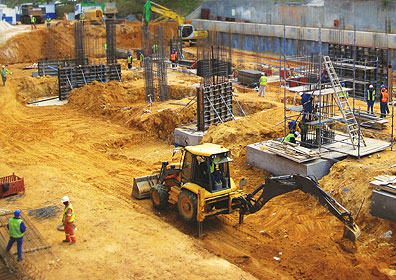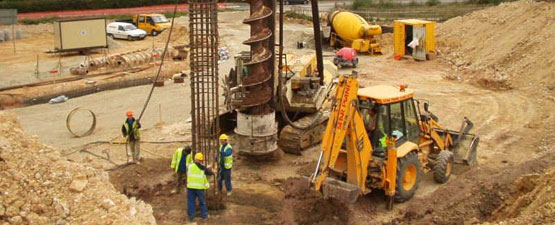Project Geotechnical Engineer Proficiency for Large-Scale Advancement
Project Geotechnical Engineer Proficiency for Large-Scale Advancement
Blog Article
Exactly How Consulting Engineers Enhance Geotechnical Engineering Projects: Insights Into Their Experience, Methodologies, and Collaborative Approaches
Consulting engineers are pivotal in enhancing geotechnical engineering tasks, applying their specialized knowledge to browse the intricacies of subsurface problems. Their methods encompass a range of site examination strategies, consisting of Requirement Infiltration Examinations (SPT) and Cone Infiltration Tests (CPT), which inform crucial decisions during the style and building and construction stages. Their collective approaches foster interaction among diverse task stakeholders, inevitably forming the job's trajectory. As we examine the complex functions these professionals play, it comes to be clear that their contributions expand beyond technological know-how, triggering a more detailed check out the effects for project success.
Function of Consulting Engineers
The know-how of seeking advice from designers in geotechnical engineering is fundamental to the effective implementation of building and construction jobs. These professionals play an essential function in evaluating dirt and rock residential properties, which are crucial aspects influencing style and construction decisions. By carrying out comprehensive site examinations, seeking advice from engineers collect necessary information that informs the design process, making certain jobs are developed on secure and ideal ground.
Consulting designers likewise give important insights into danger administration (geotechnical geologist). They determine prospective geotechnical dangers, such as landslides, dirt liquefaction, and negotiation concerns, making it possible for stakeholders to execute efficient mitigation methods. Their experience help in maximizing foundation designs, which can lead to significant cost financial savings and enhanced safety
Additionally, speaking with engineers work as an essential web link between project owners, engineers, and contractors. Their capacity to equate complex geotechnical information right into actionable recommendations cultivates partnership and promotes educated decision-making throughout the job lifecycle. This multidisciplinary method not just improves project effectiveness but additionally makes sure compliance with governing requirements and finest methods.
Trick Methods in Geotechnical Engineering

One key technique is website investigation, which includes carrying out field tests and lab analyses to collect information on subsurface conditions. Methods such as Requirement Penetration Testing (SPT) and Cone Penetration Screening (CPT) are commonly used to assess soil stratigraphy and toughness. In addition, geophysical methods, including seismic and electrical resistivity studies, supply non-invasive ways to evaluate subsurface features.
An additional essential technique is numerical modeling, which enables designers to imitate numerous situations and anticipate how soil-structure communications will behave under different loading problems. Limited Element Evaluation (FEA) is a typical approach utilized in this context.
Additionally, the style of structures, preserving structures, and earthworks relies greatly on these methodologies - geotechnical geologist. By incorporating sophisticated analytical tools with area information, getting in touch with engineers can create tailored solutions that attend to specific project obstacles, eventually adding to the stability and safety and security of building projects
Importance of Dirt Analysis
Dirt analysis offers as a fundamental element in geotechnical engineering, supplying important understandings into the physical and chemical properties of soil required for efficient building and construction preparation. Comprehending dirt features is crucial for determining its load-bearing capability, drain habits, and possibility for settlement or instability. Detailed soil investigations, visit the site including sampling and laboratory testing, help determine specifications such as soil type, moisture material, density, and shear strength.
These analyses inform the selection of appropriate building and construction techniques and materials, inevitably affecting task safety and longevity. For example, natural dirts might need different structure layouts contrasted to granular dirts, requiring tailored engineering services. In addition, dirt evaluation aids in identifying impurities that might position threats to human wellness or the setting, enabling the development of reduction techniques.
Integrating soil evaluation into the very early stages of task advancement aids to decrease unexpected obstacles, guaranteeing that designers can anticipate and resolve prospective concerns before they rise. By establishing a detailed understanding of the website conditions, getting in touch with designers can click over here now maximize design effectiveness and reduce costs, therefore improving the total success of geotechnical engineering jobs.
Joint Methods in Jobs
Effective geotechnical tasks often pivot on collaborative strategies that unite varied competence from numerous disciplines. Effective cooperation amongst speaking with engineers, rock hounds, ecological researchers, and building specialists is over here essential for attending to complicated obstacles and maximizing job end results. By leveraging the unique skills and knowledge of each team member, projects can gain from an all natural understanding of the website problems, governing needs, and design restraints.
Regular communication and interdisciplinary meetings assist in the sharing of insights and foster a culture of team effort. These joint initiatives make it possible for the identification of possible dangers early in the task lifecycle, permitting for prompt reduction methods. Additionally, incorporating comments from stakeholders, consisting of neighborhood neighborhoods and governing companies, makes sure that all perspectives are taken into consideration, improving job acceptance and conformity.
Additionally, the combination of sophisticated modern technologies, such as Geographic Details Equipment (GIS) and Building Information Modeling (BIM), additional enhances partnership. These tools enable the real-time sharing of data and visualization of geotechnical conditions, advertising educated decision-making. Eventually, a joint method not just enhances project implementation but likewise lays the structure for ingenious solutions to complicated geotechnical design challenges.
Effect On Project Results

Consulting engineers utilize sophisticated approaches such as risk analysis and anticipating modeling, which boost the precision of job forecasts. Their capacity to integrate cutting-edge innovations, like geotechnical instrumentation and data analytics, further improves the style and construction procedures. Consequently, jobs experience boosted performance, lowered expenses, and reduced hold-ups.
Additionally, promoting effective interaction and collaboration amongst staff member improves problem-solving capacities. When challenges emerge, a united front permits swift identification of remedies, avoiding possible problems. Inevitably, the collaborative efforts of consulting engineers add to better end results, ensuring that jobs fulfill both regulative criteria and client expectations.
Final Thought

Report this page